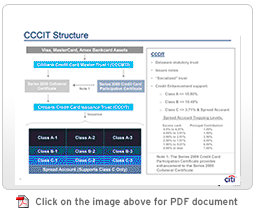Credit Card Securitization: Structure
Citibank Credit Card Master Trust I (CCCMTI or the Master Trust) was launched in May 1991, and issued in the public markets from May 1991 through December 1999. In September 2000, Citibank Credit Card Issuance Trust (CCCIT) became the primary issuance vehicle of notes supported by the credit card receivables owned by CCCMTI.
CCCIT's securities are backed by credit card receivables originated and serviced by Citibank, N.A. (rated Moody's Aa3/ S&P A+/ Fitch A+). Citibank became seller of receivables to, and servicer of, the Master Trust as a result of its merger with Citibank (South Dakota), N.A. on July 1, 2011. The eligibility criteria for the receivables that can be sold to the Master Trust include the following: the receivables must be from accounts owned by Citibank or an affiliate; the cardholders must not have been in a voluntary or involuntary bankruptcy proceeding; the receivables must be denominated in U.S. dollars.
CCCIT securities are issued in the form of notes, governed by New York law. CCCIT issues three classes of securities: Class A (rated Aaa/AAA/AAA), Class B (rated A2/AA/A), and Class C (rated Baa2/A/BBB). Classes B and C are subordinated to Class A and are part of the credit enhancement structure. The issuance of CCCIT Class B and C securities is independent of the issuance of Class A securities, however, Class A and Class B securities cannot be issued if the required enhancement for that Class (Classes B and C for A; Class C for B) is insufficient.
Following are the salient features of CCCIT securities. Please see the applicable Prospectus for a full description of the securities' mechanics.
-
Classes issued by CCCIT are grouped together for the allocation of finance charge receivable cash flows. Thus, there is a single set of monthly cash flows that generates excess spread for all the notes, rather than for individual securities. This is commonly referred to as a "socialized" trust structure. Please refer to the applicable Prospectus for the allocation order of finance charge receivables.
-
On an ongoing (monthly) basis, the Master Trust purchases credit card receivables to ensure that the face amount of securities remains outstanding until maturity, even though cardholders may pay any amount from the minimum up to the full amount owed.
-
Principal cash flows are shared across all Classes of notes. If any one Class is set to repay principal but its pro-rata share of principal cash flows (from the underlying credit card receivables) is insufficient, that Class can utilize principal from all other Classes that are not likewise needed to repay principal.
-
Credit enhancement, along with excess spread and an early amortization feature, support the ratings of each Class of security. For example, credit enhancement levels for CCCIT Class A term notes consist of 5.98291% of Class B notes and 7.97721% of Class C notes (expressed as a percentage of Class A notes). In addition, all CCCIT notes have the benefit of the Series 2009 Credit Card Participation Certificate, issued by CCCMTI on May 1, 2009. The principal amount of the Series 2009 Certificate will generally be equal to 3.84764% of all outstanding CCCIT notes. The total credit enhancement levels for each class of notes are established by Moody's, Standard and Poor's, and Fitch, and are shown in the structure slide at the top of this page.
Deutsche Bank Trust Company Americas is the trustee for CCCMTI and is the indenture trustee for CCCIT. Its principal corporate trust office is located at 60 Wall Street, Attention: Global Securities Services - Structured Finance Services, New York, New York 10005.
Sign up to receive the latest news from Citi.
Select Preferences

